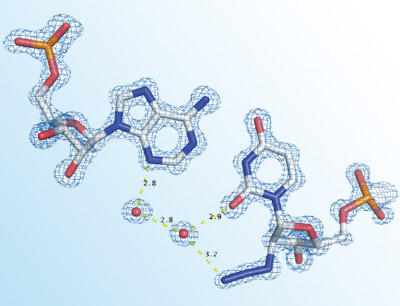Chemistry: Success Through Cooperation

In biosciences RNA interference has become one of the major tools for analyzing gene function. By using short strands of RNA molecules, scientists can target specific genes in the genome and silence them, which enables the researchers, for example, to determine their biological function in the cell. High expectations have also been placed on this tool to develop new pharmacological therapies to treat diseases. To successfully use RNA in this context, it usually has to be modified chemically. This protects the molecule from degradation processes in the cell, decreases off-target effects and prevents immune reactions. Numerous chemical modifications have been developed and tested since RNA interference was discovered. However, a simple modification of RNA molecules had previously been neglected: coupling an azido group to the molecule. A team of chemists led by Ronald Micura from the Institute of Organic Chemistry and Klaus Bister from the Institute of Biochemistry, University of Innsbruck, together with Eric Ennifar, specializing in crystallography at the University of Strasbourg, have tested this chemical modification successfully for the first time.
Modified chemically, same effect biologically
 “This
modification has been neglected because it cannot be synthesized with the
standard method,“ explains Ronald Micura. “Now we have found a way, which is
based on standard procedures, to couple the
azido group to the RNA.“ After determining its three dimensional crystal
structure at the University of Strasbourg, Klaus Bister’s research group tested
the biological function of the modified RNA. “In our experiment we used an RNA
molecule that specifically suppresses the gene BASP1,” says Bister. “We have
been investigating this gene intensively for a while now because it plays an
important role in cancer growth and so this project is of very high interest
for us.“ Biological analyses in Innsbruck showed that the chemical modification
of the RNA did not affect its biological function. “This is very important for its future
application,“ explains Katja Fauster, first author of the publication. “Another
advantage is that the modification is reactive, which means that we can add additional molecules to
the azido group.” The chemists exploited this reactivity in the experiment to
lighten up the RNA in the cell by introducing fluorescent dyes.
“This
modification has been neglected because it cannot be synthesized with the
standard method,“ explains Ronald Micura. “Now we have found a way, which is
based on standard procedures, to couple the
azido group to the RNA.“ After determining its three dimensional crystal
structure at the University of Strasbourg, Klaus Bister’s research group tested
the biological function of the modified RNA. “In our experiment we used an RNA
molecule that specifically suppresses the gene BASP1,” says Bister. “We have
been investigating this gene intensively for a while now because it plays an
important role in cancer growth and so this project is of very high interest
for us.“ Biological analyses in Innsbruck showed that the chemical modification
of the RNA did not affect its biological function. “This is very important for its future
application,“ explains Katja Fauster, first author of the publication. “Another
advantage is that the modification is reactive, which means that we can add additional molecules to
the azido group.” The chemists exploited this reactivity in the experiment to
lighten up the RNA in the cell by introducing fluorescent dyes.
New building – new communication networks
The two research groups headed by Bister and Micura, who just settled in to the new building called Center for Chemistry and Biomedicine (CCB), underline the success of interdisciplinary cooperation within the main research Centre of Molecular Biosciences (CMBI) at the University of Innsbruck. “The only thing that separates us today is a flight of stairs,” says Klaus Bister, who is very happy about the new working and research conditions in the new building at the Innrain. The communicative design of the new building promises an increase in successful joint projects within the main research area. The Innsbruck researchers are supported by the Austrian Science Fund FWF and within the framework of the GEN-AU research program funded by the Ministry of Science.